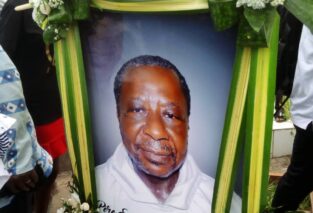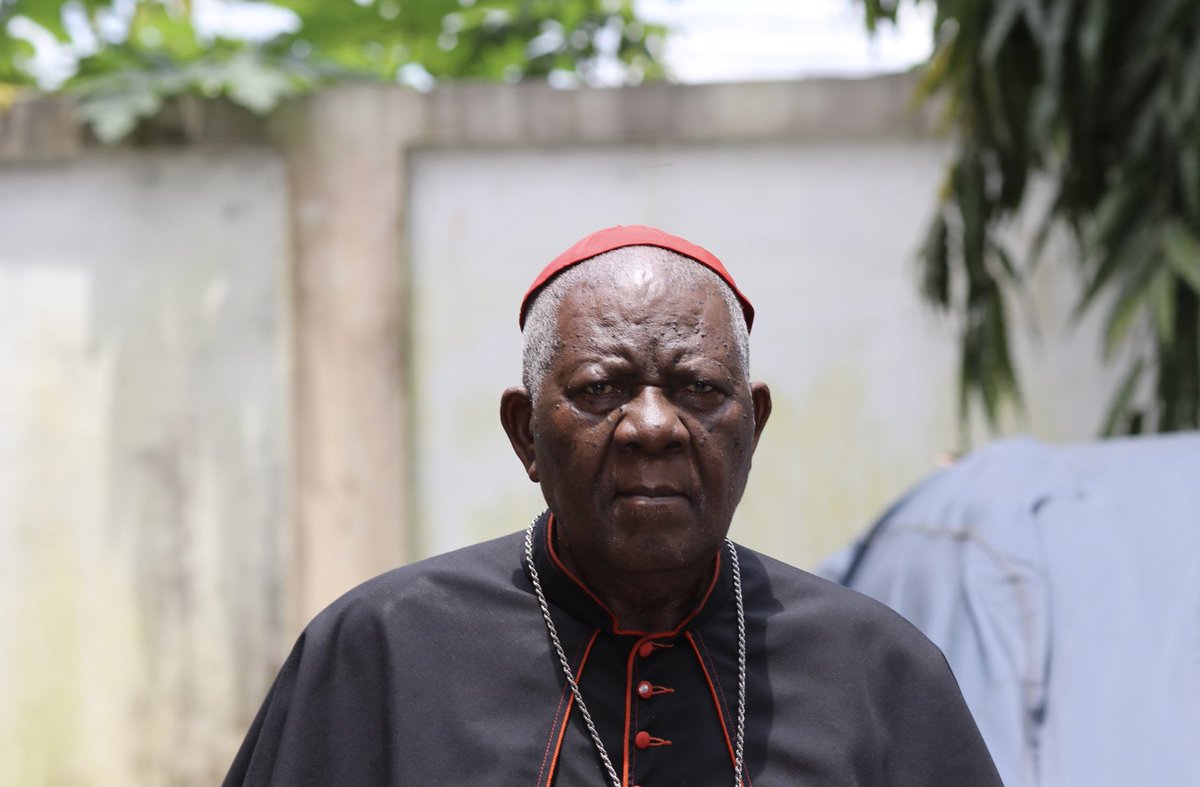On Thursday afternoon, September 14, 1995, one had the feeling that the people of Yaoundé were all moving, literally, towards one direction – the Nsimalen International Airport. Hours before the Holy Father arrived in Yaoundé, the streets through which he was to pass were already overflowing with people, many waving miniature flags of the Holy See and of Cameroon.
At the airport itself, no-nonsense security people, many of them in dark goggles, dressed in dark or black suits, frisked you thoroughly for hidden weapons: guns or knives. Occasionally, one of them would lift the lapel of his coat and screamed an order into it, or answered one from it. In their hands, walkie-talkies of various shapes and sizes incessantly blared out instructions to the bearers.
The Mbalmayo choir
When we succeeded to get into the airport, we saw the “Notre Dame du Rosaire” Choir from the Mbalmayo Cathedral rivalling the military band at the far end of the runway. The Nsimalen International Airport falls within the jurisdiction of the Diocese of Mbalmayo. The choir nearly went into a frenzy of excitement when the frail-looking, retired bishop of Mbalmayo, Monsignor Paul Etoga, the first African bishop of Francophone Africa, was led by hand to greet it.
Hundreds of bishops, for the most part in white cassocks and with crosses glistening on their chests, were already lining up alongside the red carpet the Holy Father and President Paul Biya would walk on. On the opposite side of the carpet, neatly suited ministers and diplomats were also lining up, shaking hands with new arrivals and exchanging greetings and other pleasantries.
Here comes the Pope
At 2:25 p.m, a helicopter landed and out came President Paul Biya and his wife, Chantal. They then disappeared into the waiting lounge. At 2:45 p.m, against a blue, sunny sky, an ALITALIA 747 plane, escorted by a lone jet fighter of the Cameroonian air-force, landed at one end of the airport and taxied down the runway to a spot where the red carpet ended. In the meantime, President Biya and his spouse were escorted from the lounge to the spot where the plane would stop. Photographers, cameramen and women, and other paparazzis started running back and forth, trying to get a good position from where to shoot the best pictures they could get.
At exactly 3 p.m Yaoundé time, the scheduled arrival time, the Holy Father’s plane came to a halt, prompting one foreign journalist near me to say, with a smile on his lips, that the Pope had arrived with “religious precision”. Shortly thereafter, the door of the plane flew open and a few minutes later the Holy Father, Pope John Paul II, was escorted down from the plane and put his foot down on Cameroonian soil for the second time in ten years. Gun salutes flew into the air, sending birds in the nearby forest fleeing for dear life.
Blessing the soil
The first time the Holy Father was here in 1985, the first thing he did was to go down on his knees and kiss the ground. This time around, ten years later, with the weight of age bearing down so heavily on his shoulders, he merely blessed some of the soil that was brought to him on a plate.
Then began the traditional series of handshakes and brief conversations with the people lining the red carpet; the conversation being shorter or a little longer depending on who it was he was greeting. He lingered a little longer – understandably so — with the members of the Cameroonian episcopacy and diplomats from certain countries.
Who killed Monsignor Plumey?
The highlight of the airport ceremony was no doubt President Biya’s welcome speech and the Supreme Pontiff’s response. President Biya expressed delight with the opportunity to welcome the Pope to Cameroon for the second time in ten years. He then lauded his government’s achievements in the area of democracy and respect for human rights. He said Cameroon felt truly honoured to have been chosen as the site for the promulgation of the Post-Synodal Apostolic Exhortation, Ecclesia in Africa, and wished the Holy Father a peaceful stay in our country.
For his part, the Pope expressed his delight on seeing the Cameroonian land again. He then thanked the people of Cameroon for their welcome and did not forget to send a special word of greeting in English to the Anglophone community of this country. Turning to the Catholic clergy, he said he shared their anguish over the feeling of insecurity, engendered by senseless violence that has been unleashed on them for reasons no one seems able or willing to explain. He cited the case of Monsignor Yves Plumey, the Emeritus Archbishop of Garoua, assassinated under circumstances that have so far remained a mystery.
Many observers were surprised that the head of the Catholic Church would so directly confront the head of the Cameroonian nation over the issue of insecurity which not only threatens the clergy but the ordinary people as well. Speculation was rife among journalists, particularly of the local media, as to what the Biya administration’s reaction would likely be. Whatever the case, it did seem to many of us that the slight chill that seemed to descend on the diplomatic and especially government circles at the airport that afternoon was not only caused by the rain that was then falling in Nsimalen. The Supreme Pontiff’s direct reference to the assassination of Catholic clergy and the ordinary Cameroonian did certainly lead many to a moment of silent reflection and an examination of conscience.
In the meantime, thousands of ordinary people had lined the road from Nsimalen to the city of Yaoundé to give the Pastor of the Universal Church a befitting welcome to Cameroon.
(Reproduced from L’Effort camerounais, No 31 (1028) of 23 September through 6 October 1995, pp. 15-16).
Douala, May 01, 2014


